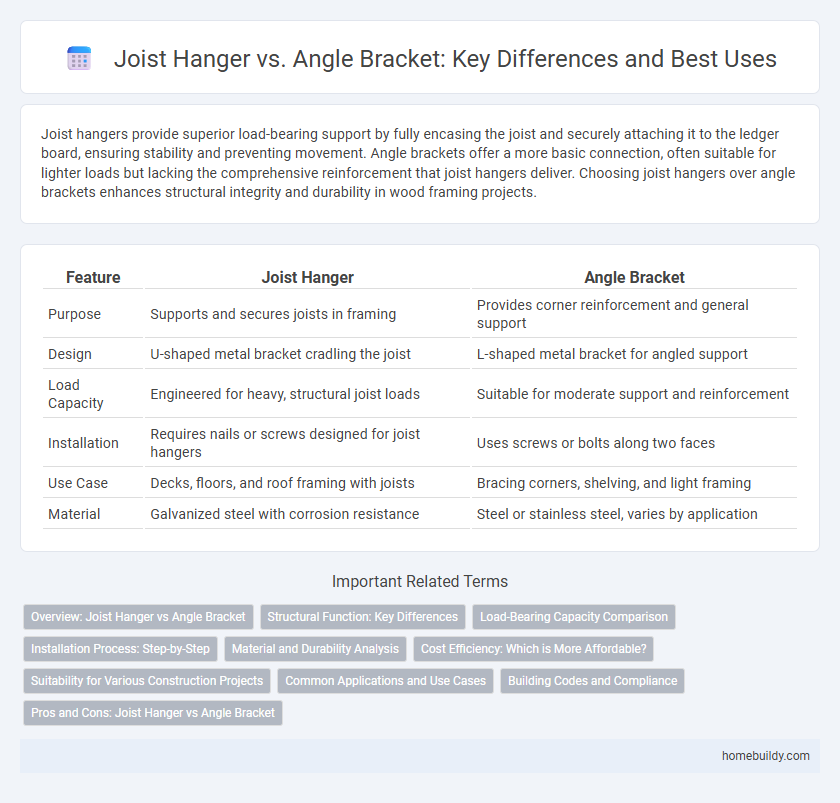Joist hangers provide superior load-bearing support by fully encasing the joist and securely attaching it to the ledger board, ensuring stability and preventing movement. Angle brackets offer a more basic connection, often suitable for lighter loads but lacking the comprehensive reinforcement that joist hangers deliver. Choosing joist hangers over angle brackets enhances structural integrity and durability in wood framing projects.
Table of Comparison
| Feature | Joist Hanger | Angle Bracket |
|---|---|---|
| Purpose | Supports and secures joists in framing | Provides corner reinforcement and general support |
| Design | U-shaped metal bracket cradling the joist | L-shaped metal bracket for angled support |
| Load Capacity | Engineered for heavy, structural joist loads | Suitable for moderate support and reinforcement |
| Installation | Requires nails or screws designed for joist hangers | Uses screws or bolts along two faces |
| Use Case | Decks, floors, and roof framing with joists | Bracing corners, shelving, and light framing |
| Material | Galvanized steel with corrosion resistance | Steel or stainless steel, varies by application |
Overview: Joist Hanger vs Angle Bracket
Joist hangers are specifically designed to support the ends of wood joists, providing a secure and load-bearing connection to beams or ledger boards. Angle brackets are more versatile metal connectors used primarily for reinforcing right-angle joints but lack the tailored support features of joist hangers for overhead loading. Choosing joist hangers ensures proper structural integrity in flooring and decking frameworks, while angle brackets are suitable for general framing and light-duty applications.
Structural Function: Key Differences
Joist hangers are engineered to provide direct vertical support by securely connecting joists to beams or ledger boards, distributing load evenly and preventing lateral movement. Angle brackets, while useful for reinforcing right-angle connections, lack the specialized design for load-bearing joist support and typically handle lighter structural loads. The key structural difference lies in joist hangers' ability to maintain joist alignment and support significant weight, ensuring stability in floor and deck framing systems.
Load-Bearing Capacity Comparison
Joist hangers provide superior load-bearing capacity compared to angle brackets due to their engineered design that evenly distributes weight across the supporting structure. Unlike angle brackets, joist hangers feature flanged edges and multiple nail points, ensuring enhanced stability and reduced risk of joint failure under heavy loads. This makes joist hangers ideal for critical structural applications requiring robust support and long-term durability.
Installation Process: Step-by-Step
Joist hangers install by first positioning the hanger on the ledger or beam, ensuring it is flush and level, then securing it with specified nails or screws predicated on manufacturer guidelines. Angle brackets require aligning the bracket at the joint and fastening with bolts or screws through pre-drilled holes, often demanding precise hole alignment for structural integrity. Joist hangers typically offer a quicker installation process due to preformed shapes and nail slots, whereas angle brackets require more measuring and drilling to match joist and beam dimensions.
Material and Durability Analysis
Joist hangers are typically made from galvanized steel with a corrosion-resistant coating, providing superior durability and strength compared to standard angle brackets, which are often constructed from plain steel or lighter metals. The galvanized steel in joist hangers enhances resistance to rust and environmental wear, making them ideal for long-term structural support in both indoor and outdoor applications. This material advantage ensures joist hangers maintain integrity under heavy loads and harsh conditions, outperforming angle brackets in longevity and reliability.
Cost Efficiency: Which is More Affordable?
Joist hangers generally offer greater cost efficiency than angle brackets due to their specialized design, which reduces installation time and material waste. While angle brackets may have a lower initial price, joist hangers' durability and precise fit minimize long-term maintenance and replacement costs. For large-scale projects, the investment in joist hangers often results in significant overall savings and enhanced structural performance.
Suitability for Various Construction Projects
Joist hangers provide superior load-bearing support for wooden beams, making them ideal for deck framing, floor joists, and roof structures requiring precise alignment and strong shear resistance. Angle brackets offer more versatility for light-duty connections but lack the specialized design needed for wide bearing surfaces in structural joist installation. For heavy timber projects demanding durability and safety, joist hangers outperform angle brackets by delivering enhanced stability and consistent load distribution.
Common Applications and Use Cases
Joist hangers are primarily used in wood framing to securely support joists and beams in decks, floors, and ceilings, providing load-bearing strength and stability. Angle brackets are more versatile for general reinforcement, suitable for joining wood or metal at various angles in furniture, shelving, and light structural tasks. For heavy-duty wood framing requiring precise load transfer, joist hangers are preferred, while angle brackets serve well in lighter, non-load-bearing applications.
Building Codes and Compliance
Joist hangers are specifically designed to meet building codes that enforce structural integrity and load-bearing requirements for floor and ceiling framing, ensuring compliance with standards such as the International Residential Code (IRC). Angle brackets, while useful for general reinforcement, may not provide the same standardized load ratings or certification required by building inspectors, potentially leading to non-compliance in critical framing applications. Using joist hangers guarantees adherence to local building codes and industry regulations, enhancing safety and durability in construction projects.
Pros and Cons: Joist Hanger vs Angle Bracket
Joist hangers provide superior load distribution and secure fastening for wooden beams, reducing the risk of structural failure compared to angle brackets. Angle brackets offer easier installation and greater versatility for various construction applications but may not support heavy loads as effectively as joist hangers. Choosing between joist hangers and angle brackets depends on the project's load requirements and installation preferences.
joist hanger vs angle bracket Infographic

 homebuildy.com
homebuildy.com